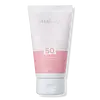What's inside
What's inside
 Key Ingredients
Key Ingredients

 Benefits
Benefits

No benefits
 Concerns
Concerns

 Ingredients Side-by-side
Ingredients Side-by-side

Titanium Dioxide 4%
Cosmetic ColorantZinc Oxide 4%
Cosmetic ColorantAllantoin
Skin ConditioningAlumina
AbrasiveButyrospermum Parkii Butter
Skin ConditioningCamellia Oleifera Leaf Extract
AstringentCetyl PEG/PPG-10/1 Dimethicone
EmulsifyingCucumis Sativus Extract
Skin ConditioningCyclopentasiloxane
EmollientDimethicone Crosspolymer
Emulsion StabilisingDisodium EDTA
Disteardimonium Hectorite
StabilisingEthylhexylglycerin
Skin ConditioningParfum
MaskingGlycerin
HumectantHexyl Laurate
EmollientLinum Usitatissimum Seed Oil
PerfumingOenothera Biennis Oil
EmollientPEG-10 Dimethicone
Skin ConditioningPhenoxyethanol
PreservativePlankton Extract
Skin ConditioningPolyglyceryl-4 Isostearate
EmulsifyingPolymethylsilsesquioxane
Rosa Canina Seed Oil
EmollientSilica
AbrasiveStearic Acid
CleansingTocopheryl Acetate
AntioxidantWater
Skin ConditioningTitanium Dioxide 4%, Zinc Oxide 4%, Allantoin, Alumina, Butyrospermum Parkii Butter, Camellia Oleifera Leaf Extract, Cetyl PEG/PPG-10/1 Dimethicone, Cucumis Sativus Extract, Cyclopentasiloxane, Dimethicone Crosspolymer, Disodium EDTA, Disteardimonium Hectorite, Ethylhexylglycerin, Parfum, Glycerin, Hexyl Laurate, Linum Usitatissimum Seed Oil, Oenothera Biennis Oil, PEG-10 Dimethicone, Phenoxyethanol, Plankton Extract, Polyglyceryl-4 Isostearate, Polymethylsilsesquioxane, Rosa Canina Seed Oil, Silica, Stearic Acid, Tocopheryl Acetate, Water
 Reviews
Reviews

Ingredients Explained
These ingredients are found in both products.
Ingredients higher up in an ingredient list are typically present in a larger amount.
Dimethicone Crosspolymer is a silicone created by modifying dimethicone with hydrocarbon side chains. Due to its large size, it does not penetrate skin. It is considered non-occlusive.
Dimethicone Crosspolymer is used to stabilize and thicken products. It also helps give products a silky feel.
Silica, also known as silicon dioxide, is a naturally occurring mineral. It is used as a fine, spherical, and porous powder in cosmetics.
Though it has exfoliant properties, the function of silica varies depending on the product.
The unique structure of silica enhances the spreadability and adds smoothness, making it a great texture enhancer.
It is also used as an active carrier, emulsifier, and mattifier due to its ability to absorb excess oil.
In some products, tiny microneedles called spicules are made from silica or hydrolyzed sponge. When you rub them in, they lightly polish away dead skin layers and enhance the penetration of active ingredients.
Learn more about Silica